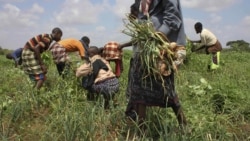In 2011, the Horn of Africa suffered the worst drought in six decades, affecting more than 14 million people. In response, the United States dedicated more than $1.3 billion dollars in humanitarian assistance to help meet the needs of some 4.6 million people.
Over the past year in west Africa, nearly 19 million people in the Sahel faced hunger again, even as many still struggle to recover from the region's last food crises in 2008 and 2010.
The cycle of drought resulting in poor harvests and rising food prices, and inevitably leading to food insecurity and malnutrition, has driven the same communities into crisis year after year. As a result, nearly half the international humanitarian assistance over the last decade has gone toward the same nine countries.
That is why the United States Agency for International Development, or USAID, is changing its approach to aiding communities that suffer chronic food shortages, from simply delivering emergency aid to also concentrating on building resilience. In other words, USAID is changing to an approach that will not only help people, their communities and countries ride out these cyclical disasters, but also training them to build infrastructure essential to agriculture, and to adapt common practices to mitigate their vulnerability to stress.
“Instead of just encouraging the public to help in a crisis, we also introduced to them to Feed the Future, President Obama’s food security initiative, as well as new development breakthroughs that can put millions on the pathway out of poverty,” said USAID Administrator, Dr. Rajiv Shah.
USAID introduced a new variety of drought- and flood- tolerant rice, and a highly nutritious type of sweet potato that will help protect children against diseases. It also advocates changing some pastoral practices, such as the selling of livestock, because a smaller herd can better weather a drought. In addition, providing fodder for the right animals at the right time, such as feeding milk goats during a drought, can reduce malnutrition and help mitigate the impact of the hunger season.
“Across [USAID], we’re fundamentally changing the way we respond to crises, turning our aspirations for resilience into real results on the ground,” said Dr. Shah. “Through building resilience, we can help prevent that desperation, save lives, and create the conditions where families and communities can prosper.”
Over the past year in west Africa, nearly 19 million people in the Sahel faced hunger again, even as many still struggle to recover from the region's last food crises in 2008 and 2010.
The cycle of drought resulting in poor harvests and rising food prices, and inevitably leading to food insecurity and malnutrition, has driven the same communities into crisis year after year. As a result, nearly half the international humanitarian assistance over the last decade has gone toward the same nine countries.
That is why the United States Agency for International Development, or USAID, is changing its approach to aiding communities that suffer chronic food shortages, from simply delivering emergency aid to also concentrating on building resilience. In other words, USAID is changing to an approach that will not only help people, their communities and countries ride out these cyclical disasters, but also training them to build infrastructure essential to agriculture, and to adapt common practices to mitigate their vulnerability to stress.
“Instead of just encouraging the public to help in a crisis, we also introduced to them to Feed the Future, President Obama’s food security initiative, as well as new development breakthroughs that can put millions on the pathway out of poverty,” said USAID Administrator, Dr. Rajiv Shah.
USAID introduced a new variety of drought- and flood- tolerant rice, and a highly nutritious type of sweet potato that will help protect children against diseases. It also advocates changing some pastoral practices, such as the selling of livestock, because a smaller herd can better weather a drought. In addition, providing fodder for the right animals at the right time, such as feeding milk goats during a drought, can reduce malnutrition and help mitigate the impact of the hunger season.
“Across [USAID], we’re fundamentally changing the way we respond to crises, turning our aspirations for resilience into real results on the ground,” said Dr. Shah. “Through building resilience, we can help prevent that desperation, save lives, and create the conditions where families and communities can prosper.”
















